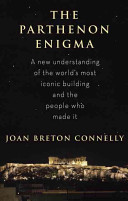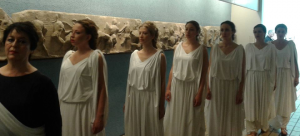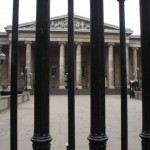Joan Breton Connelly rightly admonishes the British and other despoilers of the Parthenon to return their loot to Greece. She says that
“the deliberate and sustained dismemberment of what are some of the most sublime images ever carved by humankind brings shame on those who work to uphold this state of affairs.”

PARTHENON ENIGMA by Joan Breton Connelly
Book Review by Evaggelos Vallianatos – Scholar; Author
The polytheistic, scientific and technological culture of the Greeks culminated in an extremely sophisticated form of sculpture and architecture and city planning of the classical age, filling poleis with thousands of statues and dozens of great temples, including the Parthenon in Athens honoring the virgin goddess Athena.
Building the Parthenon was, first of all, a massive public works project. Plutarch, priest of Apollo and philosopher, writing almost six centuries after the Athenians built the Parthenon in the fifth century BCE, left a few valuable clues on the history of the Parthenon.
He reported that the materials used for its construction included marble, bronze, ivory, gold, ebony and cypress-wood. Some 200 craftsmen and 50 sculptors did the lions’ work in constructing the temple of the virgin goddess Athena.
Plutarch praised Perikles under whose leadership Parthenon came into being. The works of Perikles, he said, were done “in a short time for all time.”
William Martin Leake, a British traveler and philhellene, visited Athens in the 1810s. In 1821, he extolled the “magnificent” Parthenon, “which, by its united excellences of materials, design and decorations, was the most perfect ever executed.”
Another philhellene, the French philosopher Ernest Renan, visited the Acropolis in 1865 and fell in love with the beauty and sacredness of the Parthenon. He admitted that, “Greece had created science, art, philosophy and civilization; but the scale failed me. When I saw the Acropolis, I have had the revelation of the divine.” In addition, Renan equated the beauty of the Parthenon with “absolute honesty,” reason and the respect Greeks had towards their gods. He said the hours he spent on the Acropolis were “hours of prayer” to Pallas Athena.
A 20th-century student of ancient Athens, R. E. Wycherley, noted that the Parthenon was the
culmination of Greek architecture… The temple dominated the Acropolis and was the crowning glory of the city… It was elaborately designed, and… worthy offering to Athena and a splendid symbol of the power and achievement of Athens.
E. Guhl and W. Koner, German scholars, also of the 20th century, documented that works of architecture “produce the grandest and most powerful impression and give the most distinguishable character to the life of a nation.” This was particularly true with the Greeks who “were enabled and gifted more than any other nation” in rendering “the innermost nature of their genius in external works of art.”
Just like the Greeks designed the world’s first computer 2,200 years ago in order to unite the heavens and Earth, they also brought together the celestial and temporal in their temples. According to Guhl and Koner, “the temple became the rallying-point of everything good, noble and beautiful, which we still consider as the glory of Greek culture and refinement.”
The American classics scholar, Jon D. Mikalson, agrees. He speaks of the divine origins in Greek architecture, the “inclination” of the Greeks “to give to their gods only what was beautiful.” The result of this piety, he says, “filled their cities and villages… with temples, statues and dedications of unsurpassed beauty.”
According to Mikalson:
Most of what we think of as characteristically Greek in architecture, sculpture, mythology, lyric poetry, tragedy, and comedy owned its origins and, especially in the Classical period, its development to the religious institutions and practices of the Greek people. The cultural environment in which the Greek individual lived, whether in Athens or Sparta or Thebes, was significantly determined by his religion and that of his ancestors.
The Parthenon was the jewel of Greek religion. Like an ageless celestial mirror, it also reflected the power, patriotism, democracy and artistic and technical achievements of Athens, the premier Greek polis in the fifth century BCE.
The Parthenon Enigma (Alfred A. Knopf, 2014) highlights this refreshing interpretation of Greek history. Its author, the American classics scholar Joan Breton Connelly, is admirable because she sees the Greeks mostly as the Greeks saw themselves. This is no small achievement in an age that is fashionable even for classical scholars to hate the Greeks.
In her 2007 book, Portrait of a Priestess, Connelly argued convincingly women in ancient Greece were not second-class citizens, especially in religious practices. Now in her masterful story, The Parthenon Enigma, she breaks new ground once again — explaining the Greeks in terms of their relationships with their gods. Yes, Athens had plenty of philosophers and radical democrats, but above all else Athens had people pious to the gods and Athena in particular.
The Parthenon, Connelly says, was “first and foremost a religious building,” a “supernal” temple that facilitated beliefs and rituals at the “very fabric of [Athenian] life.” It wedded metaphysical understanding and civic solidarity among citizens who knew they were autochthonous Greeks. The Parthenon told them to protect their polis from “exotic, barbaric outsiders.” This made the Parthenon an “epitome of Athenian self-awareness.”
Christians and, eventually, Moslems desecrated, plundered, bombed and wrecked the Parthenon. But, like Plutarch said, the Parthenon remains untouched by time.
Read The Parthenon Enigma. It is a very important book: thoroughly researched and written for the intelligent reader. It is original, insightful and convincing.
Despite the ceaseless barbarities against Greece, including the unforgivable and atrocious colonialism of the European Union and America in Greece since 2009, Greek values are at the foundation of the West. Connelly’s book reminds us of that.
Connelly rightly admonishes the British and other despoilers of the Parthenon to return their loot to Greece. She says that the “deliberate and sustained dismemberment of what are some of the most sublime images ever carved by humankind brings shame on those who work to uphold this state of affairs.”




Recent Comments